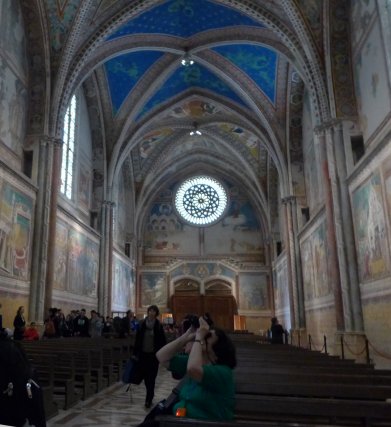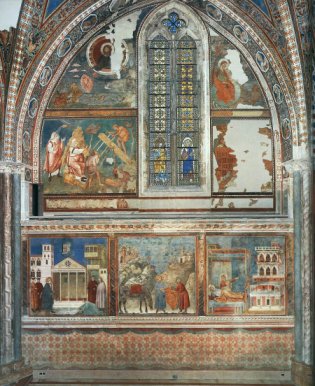|
The Upper Church |
|
|
| Studying the art in the
Upper church would seem to be more straight-forward than in the lower
church, which has all those chapels to consider. As you may have
guessed, this isn't the case. One major problem here is the obsession among art critics with attribution. Did Giotto paint some or all of these images? if not, who did? Could it have been Cavallini from Rome? Or Jacopo Torriti? And which bits did Cimabue do? The romantic notion of the solitary artist just will not go away. For a sensible account of the creation of these frescoes read Giotto and the St Francis cycle in Assisi by Bruno Zanardi. * This makes it clear that the timescale involved required a large team of painters working to to a strict pre-ordained plan. Was Giotto involved? Possibly. Some of the images have been compared to those undoubtedly by Giotto in the Scrovegni chapel in Padua. Well, Giotto knew the work in Assisi, and may well have been influenced by it, but anything beyond that may just be wishful thinking. There are other, and I would say, more interesting things to think about here; sadly, few art historians do so. * Cambridge Companion to Giotto. So what are they? The first thing to be said is that studies of the chapel focus almost entirely on the sequence of frescoes showing the events of the life of St Francis. In a way this is understandable; many of the other frescoes are in poor condition, and some have disappeared entirely. However, considering the whole scheme is vital if we are to grasp what is going on here. |
|
|
| The frescoes in the four bays of the nave are in three
registers. On the north side (the right if you enter through the east
doors) the lower register has the St Francis frescoes, while the middle
and top registers (on either side of the windows) show Old
Testament scenes. On the south side the St Francis frescoes continue,
while in the middle and top registers there are scenes from the New
Testament. The transepts and apse have a different layout. Immediately there is a problem. The right hand side is traditionally considered the holiest, and it is here that the New testament scenes of the life and death of Christ should appear. What's gone wrong? We have come in through the wrong door. The scheme is meant to begin in the transepts, continue to the east end, then return via the south wall. Enter from the west end (which you can do via the stairs from the Lower Church) and all falls into the correct place. Why is this? It needs to be born in mind that the original purpose of the Upper Church was as a chapter house, for the exclusive use of Franciscan friars and, presumably, novitiates. They would have entered from the Convento Sacro, from the west end. The east doors did not exist - if you look at early plans of the complex, you will see why; the great mound of earth to the east of the complex on to which those doors open was not there, and there was almost certainly an east door to the lower church at ground level. Where the east doors are now, there may well have been an altar. Once pilgrims were allowed in in the fourteenth century an iconostasis was installed between nave and transept, not removed until the sixteenth century. What is the function of the frescoes? It is often thought that narrative scenes on church walls are there to educate the ignorant and illiterate. But these frescos go well beyond this; the friars assembled there would know the stories perfectly well. The images here take the theology to a much higher level, and, in some respects, a contentious one. The commissioners of the St Francis narratives, which are mainly based on the Life of St Francis by Bonaventure, had to tread carefully to avoid any suggestion of heresy, a potent issue at the time. As with the frescoes in the lower church, the images present Francis as a second Christ, and it might be thought that this was heretical enough. Not at all; the church authorities, and the Pope himself, had no problem with that. The problem was with the division of the Franciscan movement into two groups. The Spiritual Franciscans followed Francis's teaching that absolute poverty was vital. The Conventuals were moving away from this, and the splendour of the basilica itself is ready testament to that. It was the insistence on poverty that worried the church; if Francis was right, then what of their own wealth? Those commissioners had to tread a careful line. I'll look at the the theology in more detail on the following pages. The sequence The fresco narrative begins on the east wall of the south transept, continues via the apse and north transept, then around the nave. To follow this, continue by clicking on 'the Transepts and Apse' below. A word on Bonaventure. Bonaventure's Life is surprisingly readable, though as with the frescoes he was not aiming at a narrative in chronological order. The book begin with the early life of Francis, and ends with his death and posthumous miracles, but the main part of the book offers examples of the activities of Francis that demonstrate his particular virtues: poverty, humility, and so on. In a sense, the book can be compared to a gospel narrative, and I am sure that this parallel was not lost on the book's readers. |
|
|

